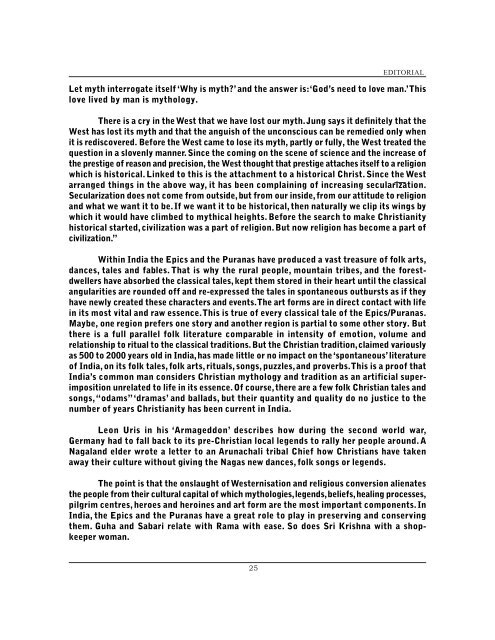Epics in Imprints-1.pdf - Vivekananda Kendra Prakashan
Epics in Imprints-1.pdf - Vivekananda Kendra Prakashan
Epics in Imprints-1.pdf - Vivekananda Kendra Prakashan
You also want an ePaper? Increase the reach of your titles
YUMPU automatically turns print PDFs into web optimized ePapers that Google loves.
25<br />
EDITORIAL<br />
Let myth <strong>in</strong>terrogate itself ‘Why is myth?’ and the answer is: ‘God’s need to love man.’ This<br />
love lived by man is mythology.<br />
There is a cry <strong>in</strong> the West that we have lost our myth. Jung says it def<strong>in</strong>itely that the<br />
West has lost its myth and that the anguish of the unconscious can be remedied only when<br />
it is rediscovered. Before the West came to lose its myth, partly or fully, the West treated the<br />
question <strong>in</strong> a slovenly manner. S<strong>in</strong>ce the com<strong>in</strong>g on the scene of science and the <strong>in</strong>crease of<br />
the prestige of reason and precision, the West thought that prestige attaches itself to a religion<br />
which is historical. L<strong>in</strong>ked to this is the attachment to a historical Christ. S<strong>in</strong>ce the West<br />
arranged th<strong>in</strong>gs <strong>in</strong> the above way, it has been compla<strong>in</strong><strong>in</strong>g of <strong>in</strong>creas<strong>in</strong>g secularization.<br />
Secularization does not come from outside, but from our <strong>in</strong>side, from our attitude to religion<br />
and what we want it to be. If we want it to be historical, then naturally we clip its w<strong>in</strong>gs by<br />
which it would have climbed to mythical heights. Before the search to make Christianity<br />
historical started, civilization was a part of religion. But now religion has become a part of<br />
civilization.”<br />
With<strong>in</strong> India the <strong>Epics</strong> and the Puranas have produced a vast treasure of folk arts,<br />
dances, tales and fables. That is why the rural people, mounta<strong>in</strong> tribes, and the forestdwellers<br />
have absorbed the classical tales, kept them stored <strong>in</strong> their heart until the classical<br />
angularities are rounded off and re-expressed the tales <strong>in</strong> spontaneous outbursts as if they<br />
have newly created these characters and events. The art forms are <strong>in</strong> direct contact with life<br />
<strong>in</strong> its most vital and raw essence. This is true of every classical tale of the <strong>Epics</strong>/Puranas.<br />
Maybe, one region prefers one story and another region is partial to some other story. But<br />
there is a full parallel folk literature comparable <strong>in</strong> <strong>in</strong>tensity of emotion, volume and<br />
relationship to ritual to the classical traditions. But the Christian tradition, claimed variously<br />
as 500 to 2000 years old <strong>in</strong> India, has made little or no impact on the ‘spontaneous’ literature<br />
of India, on its folk tales, folk arts, rituals, songs, puzzles, and proverbs. This is a proof that<br />
India’s common man considers Christian mythology and tradition as an artificial superimposition<br />
unrelated to life <strong>in</strong> its essence. Of course, there are a few folk Christian tales and<br />
songs, “odams” ‘dramas’ and ballads, but their quantity and quality do no justice to the<br />
number of years Christianity has been current <strong>in</strong> India.<br />
Leon Uris <strong>in</strong> his ‘Armageddon’ describes how dur<strong>in</strong>g the second world war,<br />
Germany had to fall back to its pre-Christian local legends to rally her people around. A<br />
Nagaland elder wrote a letter to an Arunachali tribal Chief how Christians have taken<br />
away their culture without giv<strong>in</strong>g the Nagas new dances, folk songs or legends.<br />
The po<strong>in</strong>t is that the onslaught of Westernisation and religious conversion alienates<br />
the people from their cultural capital of which mythologies, legends, beliefs, heal<strong>in</strong>g processes,<br />
pilgrim centres, heroes and hero<strong>in</strong>es and art form are the most important components. In<br />
India, the <strong>Epics</strong> and the Puranas have a great role to play <strong>in</strong> preserv<strong>in</strong>g and conserv<strong>in</strong>g<br />
them. Guha and Sabari relate with Rama with ease. So does Sri Krishna with a shopkeeper<br />
woman.

















